The berries are setting on well here on the NW coast.
Kids been eating handfulls of Blue Berries, semi ripe Cranberries and the Crow Berries(Locals call em black berries cause ther almost bvlack color) this seems to have a mild laxative effect but they love ther berries and ther having fun, now have barries in pancakes, in tea, and kids favorite smoothies

.
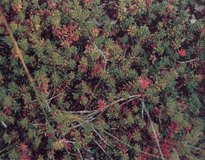
[size=-2]Photo by Karen Brewster[/size]
Technical name: Empetrum nigrum
Inupiat name: Asiaq
Common name: Crowberry, in Point Hope, its called Blackberry.
Family: CrowberryThis plant is found on the tundra. Its leaves are opposite on woody branches. They look like needles on a Christmas tree. In the fall the plants have a small dark, almost black, round berries.
USES: Mostly people in Point Hope gather the berries and eat them fresh. The berries are also used in pies, and some people mix the berries with fish livers to make dish called tingook.
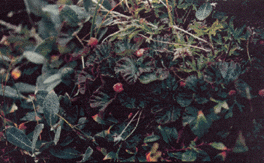
[size=-2]Photo by JBaldassare Mineo[/size]
Technical name: Rubus chamaemorus
Inupiat name: Aqpik
Common name: Cloudberry
Family name: Rose
This plant is found on wet tundra. The leaves are simple and palmate, and the edges are jagged. The flower has five white petals. The plant has a berry that is light orange when they are ripe. The berry looks like a clump of salmon eggs.
USES: Pick the berries and eat them fresh!! They are good. They can also be stored in oil. |
[size=-2]photo s by Jana Harckeck[/size]
Technical name: Hedysarum alpinum
Inupiat name: Masu
Common name: Eskimo Potato
Family: Pea
This plant grows in gravelly, but kind of wet areas. It is pretty big - about 12 inches or more with lots of leaflets on branches off the stem. The flowers are purple and there are a lot of them on lined up on the top of the stem.
USES: The long root is dug up in the fall or spring and eaten either raw or boiled. It can be stored buried in the sand or in a barrel covered with dirt. This keeps them from drying out, and keeps the mice out of them. |
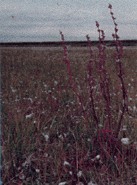
[size=-2]Photo by Jana Harcharek[/size]
Inupiat name: quagaq
Common name: Sour Dock
Family: BuckwheatThis plant is found in damp places. The leaves are oval shaped. The floweres are on spikes, and not very big. The plant grows tall-10 or more inches. In the fall the whole plant turns red as in this picture.
USES: This plant is gathered while the leaves are green. The leaves are cooked with a little water and sugar. It tastes a little like spinach.
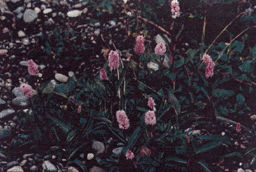
[size=-2]Photo by Baldassare Mineo[/size]
Technical name: Polygonum bistorta
Inupiat name: Ippik
Common name: Pink Plumes
Family: BuckwheatThis plant is found in wet tundra. We found some in low areas between the airport and town. The leaves are lanceolate. The flowers are pink. the head of the flower is big and fluffy with lots of petals. The height of the plant is about 8 inches.
USES: The leaves are gathered and cooked with flour and sugar during the spring and summer. The leaves can be stored in a barrel with seal oil. The leaves can also be eaten raw.

[size=-2]Photo by Karen Brewster[/size]
Technical name: Oxyria digynia
Inupiat name: Qunullig
Common name: Mountain Sorrel
Family: BuckwheatThe plant is found by the lagoon on east side which is wet peat soils. The leaves are basal and heart shape. The color of the flower stalk is pink. It is about 7 to 8 inches tall.
USES: The leaves are gathered and cooked with sugar since they are sour. The can be stored after they are cooked in zip lock bags or jars.
[size=-2]Photo by Baldassare Mineo[/size]
Technical name: Pedicularis sudetica
Inupiat name; Qutliiraq (wooly lousewort?)
Common name: Fern Leaf Lousewort
Family: FigwortFound in wet areas, this plant has dark rose colored flowers. Like the common name says, it has leaves that look like ferns and are at the base of the plant.
USES: The Inupiat name qutliiraq seems to apply to all the louseworts, which makes sense since all the louseworts can be eaten. Flowers can be picked and fermented in water then eaten with oil and sugar. the roots can be eaten fried, boiled or raw. Be careful eating the roots because they can make you sleepy.
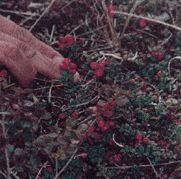
[size=-2]Photo by Jana Harcharek[/size]
Technical name: Vaccinium vitis-idaea
Inupiat name: Kikminnaq
Common name: Low-bush Cranberry
Family: Heath/EricaceaeThis plant is found on wet tundra and in bogs. It has pink bell-shaped flowers, and later bright red berries. The small oval leaves are thick and shiny. The plant grows real low to the ground.
USES: The berries are picked mixed with sugar and eaten fresh. They can also be stored in a cloth bag hung up in an ice celler. They freeze and stay nice and fresh. The cranberry juice can be used to clean out your system or if someone has a urinary infection
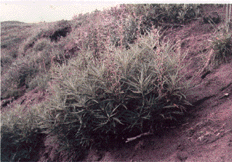
[size=-2]Photo by Jana Harcharek[/size]
Technical name: Artemisia tilessii
Inupiat name: saraigruaq
Common name: Tall Wormwood
Family: Aster
Found in sandy, but not salty areas like along the shore of the lagoon. The leaves are palmate and alternate. The flowers are small, yellow and clustered on the top of the top of the plant.
USES: This is a very useful medicinal plant. The leaves are gathered when the plants are fully leafed out. Don't keep the leaves in a damp place or they will mold. Dry them and then store them in a cloth bag, not plastic. They can be used for sore throats and coughs or colds. Chew the leaves and swallow the juice, but spit the leaves out.
Some people make a tea out of the leaves and drink a half a cup in the morning and a half a cup at night when they are sick.
The leaves can be used for cuts too. Lay the leaves over the cut and wrap a bandage around it. The wormwood will keep out infection. For toothaches, pack some leaves around the tooth that is hurting.
Some people use the leaves for aching joints like knees. Wrap the leaves over the aching or swollen joint, and hold in place with a cloth. Leave the leaves on for three days, then the joint will feel better.
|
| Leaves |
| | Charighik | | I˝upiaq Name: | Charighik | | phonetic spelling: | chari-gha-ik | | plural: | Charighit | | translation /other information | none known | | English Name: | Stinkweed, Wormwood | | Scientific Name | Artimessia tilesii | | Source: | Ledeb p.31 |
| 
| 
|
| | |
The plant is found every where in Golovin. Charighik is in the Composite family and has very small heads that contain many flowers on one head. These heads are yellowish but are not as distinct as the leaves. The large leaves are deeply lobed and have a silvery-green color. The distinctive aroma of charighik has given it the nickname, "stinkweed". I don't find the smell unpleasant but it has earned the nickname stinkweed, none the less. One of the village women, Laura Esparza, told me she rubbed charighik leaves all over her hands after she had butchered a walrus to take away the smell. So there are benefits to the odor of stinkweed.
Charighik is a useful medicinal plant that virtually everyone in Golovin knows about. Fewer people actually use the plant to help cure colds, skin problems, and any wounds, but I heard many stories of it's miracle curing abilities. My grandma told me one story about when my father, Ronald Punguk, was young. They had a fish camp at Council, Alaska, 40 miles up the Fish River, from Golovin. While Ronnie was preparing fish to dry, he cut himself between his fore finger and middle finger. My Grandpa Ralph put charighik in the cut and it healed in just a few days.
Stinkweed: "Charighik"
a description by Florence Willoya |
Stinkweeds are valuable to todays Eskimos. They were especially valuable long ago before there was medecine. Today if you are out camping and do not have modern medecine, or your medecine is not working, use the stinkweed.
Stinkweed is found in dry areas with many other plants. It usually grows in clusters. When the weed turns brown it is picked and made into a medicine.
Sometimes the weed is boiled about 10 minutes and brewed into a drink which a person feeling poorly drinks. This cleans out the stomach and system.
Sometimes the weed is made to put on an infected area. The leaves are rubbed back and forth in the hands until they are as soft as cotton, then put directly on the infection. This is left for about twenty four hours. Then changes again and again until the affected area is healed.
The stinkweed is used today by the older Eskimos to help them get well. It is now used only when no other medication can help the sick person. It is no longer used by young people; they would rather go to a doctor for medicine.
Stinkweed has an unpleasant smell and they taste strong but they certainly can help a very sick person get well. |
Another Elder, Maggie Olson described to me one of her first experiences with charighik. "In 1941 there was a hard measles epidemic in Solomon, and we all got sick, except Mama and Papa. And then, you know when you break out then you itch, and I scratched mine too much. I got sores and I have scars on 'em. I had one right on my elbow and you know they'll turn into like enphantigo where they're deep. And they get a scab, and you press the scab then mucus would ooze out. Same way with on my knees and around here, both places; I have scars about that deep (she held her fingers up, motioning about a quarter of an inch deep), that big. Right in here. So, Mama's older sister, you know she knew the cures, the Native cures. . . She saw me trying to bandage my sores. . . and this was in the fall, maybe like September, so she told me to pick stinkweed. By then they were turning brown. And she said you rub 'em between your palm's, until the outer skin, you know, drops off and becomes like a cotton ball; kind of white, like a cotton ball. Then you lay them on your sores. Put 'em there and lay them on your sores, and at that time we didn't have band-aides, so I used gauze and adhesive tape. And they finally healed; you know that stinkweed absorbed that stuff coming out."
To make tea: gather dried stems of charighik. The leaves should be dry and crisp to the touch. Remove the leaves and boil them in water for about 10 minutes. Drink the liquid to help fight colds, flu, and other ailments. To make poultice: rub the dry leaves to make a cottony material, then mix with vaseline to apply to the wound or skin sores. Maggie mentioned that people even used to put the dry leaves directly on the chest of a person with a cold, it acts like Vics vapor rub. The plant is also useful as an insect repellent. The green leaves can be burned in a fire to keep flies and other insects off hanging fish on the rack. You can also rub the green leaves over exposed skin and to keep mosquitoes and gnats from bothering you. My Grandma Florence said that people also prepare bath water with charighik mixed in and this is good to relieve arthritis pain. |
Labrador tea
Uses
The Athabaskans brew the leaves as a beverage, and also as medicine for weak blood, colds, tuberculosis, dizziness, stomach problems, heartburn, kidney problems and hangover. Some people chew the raw leaves because they enjoy the flavor. Others use Labrador tea to spice meat by boiling the leaves and branches in water and then soaking the meat in the tea.
The Pomo, Kashaya, Tolowa and Yurok of Northern California boiled the leaves of Western Labrador Tea similarly, to make a medicinal tea.[1]
In medieval Northern Europe, R. groenlandicum and R. tomentosum were often brewed in "gruit" ales, prior to the adoption of hops.
Labrador tea contains ledol, a poisonous substance that can cause cramps and paralysis |
|